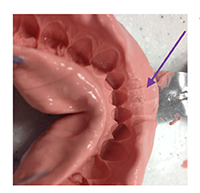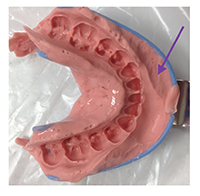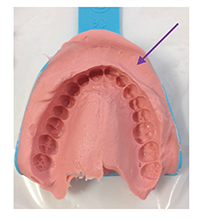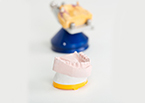 Alginate is an elastic impression material made from seaweed. It also contains sodium alginate, calcium sulphate and trisodium phosphate. These are known as ‘retarders’, and are chemicals used to slow the setting time. Alginate is used to take primary impressions for applications such as denture construction, to aid the fabrication of appliances, and to cast study models for diagnostic purposes.
Alginate is an elastic impression material made from seaweed. It also contains sodium alginate, calcium sulphate and trisodium phosphate. These are known as ‘retarders’, and are chemicals used to slow the setting time. Alginate is used to take primary impressions for applications such as denture construction, to aid the fabrication of appliances, and to cast study models for diagnostic purposes.
When alginate is in its sol (original) state it is usually in the form of a powder. When mixed with water, it forms a gel. In this gel form it solidifies into an elastic mass capable of producing a negative reproduction of the oral cavity (an impression). This is then used to create a positive reproduction (study model).
Alginate is sometimes referred to as an irreversible hydrocolloid because once it is mixed a chemical reaction has occurred. Therefore, it can never return to its sol state of powder and water. Alginate is the most universally utilised impression material in dentistry.
Properties of Alginate
• Good surface detail
• Reaction is faster at higher temperatures
• Elastic enough to be drawn over the undercuts, but tears over the deep undercuts
• Not dimensionally stable on storing due to evaporation
• Non-toxic and non-irritant
• Setting time can depend on technique
• Alginate powder is unstable on storage in presence of moisture or in warm temperatures¹
Advantages of Alginate
1. Non-toxic and non-irritant
2. Good surface detail
3. Ease of use and mixing
4. Cheap and good shelf life
5. Setting time can be controlled with temperature of water used
Disadvantages of Alginate
1. Poor dimensional stability
2. Incompatibility with some dental stones
3. Setting time very dependent on operator handling
4. Messy to work with¹
Setting Time
Alginate can be purchased with a variety of setting times. These are normal set, fast set and extra-fast set. The setting time dictates the working time and the actual setting time of the material. Working time is the time it takes to mix the alginate into a smooth, consistent mix, load the tray and seat it in the mouth. Setting time is the time it takes for the alginate to set into an elastic mass.
Chromatic Alginate
Some alginates have colour-changing properties built in. These are designed to indicate to the user how much time should be spent mixing, when to load the tray and finally when to seat the mixture in the mouth. For example, Tropicalgin is a yellow powder which will turn red when mixed with water and change to a dark pink as it is mixed. By the time it has turned peach-coloured, it should be loaded into the tray. Finally, it will turn back to yellow as it is seated. Different manufacturers have different colour-change systems, but the advantage of all systems is that they allow the operator to see exactly how much working time they have and to avoid the impression being seated in the mouth too early. Overall, this creates a more comfortable experience for the patient, especially if they have a gag reflex.
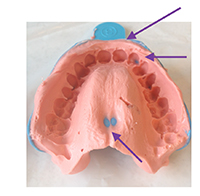 Common Faults with Alginate Impressions
Common Faults with Alginate Impressions
Impression tray visible in the upper right canine region. No peripheral roll in labial sextant. Voids in palate would mean unsuitable if being used to construct a denture.
How to correct this?
Tray possibly under-loaded with alginate. Ensure tray is adequately loaded. Also ensure upper lip is fully released, allowing alginate to flow fully into sulcus area.

Impression tray not seated correctly - placed too lingually - denoted by thicker layer of alginate labially. No lingual roll. Air bubbles present in mix.
How to correct this?
Seat tray further forward so teeth are more central in trough of impression tray. Encourage patient to lift tongue so alginate flows into lingual sulcus.
Tray moved upon seating.
How to correct this?
Ensure tray is in ideal position with teeth seated centrally in trough of impression tray before applying even pressure to seat tray.
Air bubbles present all over impression due to inadequate mixing. Incomplete peripheral roll. No lingual roll.
How to correct this?
Ensure adequate spatulation has taken place. Alginate should be of a smooth consistency with all powder incorporated into mix and no air bubbles. Accurate mixing can be aided by use of alginate mixing machine. Release lip in labial area to ensure alginate flows into this area. Remember to ask patient to lift their tongue.
Tray not seated correctly; placed too far lingually, resulting in lack of marginal detail in labial area and no peripheral roll.
How to correct this?
Teeth should be centrally seated in tray, which should be seated further into mouth, so teeth are closer to front of tray.
Inadequate labial margins and incomplete peripheral roll.
How to correct this?
Tray is not seated in mouth correctly. Tray should have been seated further into mouth so as to avoid large amount of alginate in the anterior of the tray.
Tray too big, evident by the thick border of alginate between the edge of the impression tray and the dental structures.
How to correct this?
Tray selection needs improvement in order to gain a better quality impression and for patient comfort.
 Insufficient detail in labial area
Insufficient detail in labial area
How to correct this?
Ensure lower lip in labial area is released, allowing alginate to flow into buccal sulcus. Tray may also have been under-loaded with alginate.
This image also demonstrates an alginate impression taken on a patient with a fixed retainer in place.
References
(1). http://www.dentistry.bham.ac.uk/cal/impress/algind.html
Photographs taken by Rachel Hughes RDN.OHE.Cert.Radiography.PTLLS.

